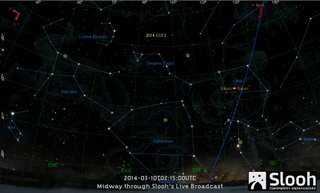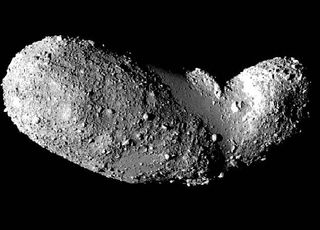Live Webcast Helps Track Large Newfound Asteroid Tonight: How to Watch

An asteroid at least the size of a 60-story building will make a distant flyby of Earth this week, and you watch astronomers track the space rock tonight (March 9) in a live webcast, weather permitting. The asteroid poses no threat to Earth.
The online Slooh community observatory will host the free webcast at 10 p.m. EDT (0200 GMT) to track asteroid 2014 CU13, a space rock about 623 feet (190 meters) wide discovered on Feb. 11 that will pass Earth at a range of about eight times the distance between Earth and the moon on Tuesday (March 11). The average Earth-moon distance is about 239,000 miles (385,000 kilometers), so eight lunar distances is about 1.9 million miles (3 million km).
You can watch the asteroid webcast live on the Slooh website, with streaming views from Slooh's remotely operated telescope in the Canary Islands, off the west coast of Africa. You can watch the asteroid webcast live on Space.com here.

"Slooh is featuring 2014 CU13 in a live broadcast from its flagship observatory at the Institute of Astrophysics of the Canary Islands on Sunday, March 9th … in order to call attention to this asteroid so that amateur astronomers will help further pinpoint its orbit," Slooh officials said in a statement. [Photos of Potentially Dangerous Asteroids]
Astronomer Jose Luis Galache of the Minor Planet Center — which catalogs near-Earth asteroid discoveries at the Smithsonian Astrophysical Observatory in Cambridge, Mass. — will answer questions from viewers using the Twitter hashtag #asteroid. Slooh host and observatory director Paul Cox will host the online discussion.
"Discovering near-Earth asteroids has become an automatic process for the survey telescopes, but discovery is just the beginning — there is so much science to do after that!" Galache said in a statement. "Amateur astronomers with access to pro-level telescopes under dark skies are in a great position to learn more about an asteroid than just where it's going."
Tonight's Slooh webcast follows three close flybys of asteroids last week in which newly discovered space rocks buzzed the Earth at a distance inside the orbit of the moon. The third of those flybys, which occurred Thursday (March 6), brought the small asteroid 2014 EC extremely close to Earth, within 38,300 miles (61,600 km) .
Get the Space.com Newsletter
Breaking space news, the latest updates on rocket launches, skywatching events and more!
"This is not an unusual event," Paul Chodas, a senior scientist in the Near-Earth Object Program Office at NASA's Jet Propulsion Laboratory in Pasadena, Calif., said in a statement at the time. "Objects of this size pass this close to the Earth several times every year."

The first asteroid found in 2014 actually hit the Earth, but it was tiny. The asteroid, called 2014 AA, was about the size of a car was discovered Jan. 1 and broke apart in Earth's atmosphere by Jan. 2.
Slooh officials said tonight's webcast of asteroid 2014 CU13 is a follow-up to the group's Feb. 18 tracking of asteroid 2000 EM26, a space rock with an orbit so poorly defined that it's gained the nickname "Moby Dick."
"We are going to rally citizen astronomers to help us help the Minor Planet Center and NASA/JPL track these near-Earth objects. As we've seen with Moby Dick, all the effort that went into its discovery is worthless unless follow-up observations are made to accurately determine their orbits for the future", Cox said in a statement. "And that's exactly what Slooh Members are doing with NEA 2014 CU13 — using Slooh's robotic telescopes to accurately measure the precise position of this newly discovered asteroid."
Email Tariq Malik at tmalik@space.com or follow him @tariqjmalik and Google+. Follow us @Spacedotcom, Facebook and Google+. Original story on Space.com.
Join our Space Forums to keep talking space on the latest missions, night sky and more! And if you have a news tip, correction or comment, let us know at: community@space.com.

Tariq is the Editor-in-Chief of Space.com and joined the team in 2001, first as an intern and staff writer, and later as an editor. He covers human spaceflight, exploration and space science, as well as skywatching and entertainment. He became Space.com's Managing Editor in 2009 and Editor-in-Chief in 2019. Before joining Space.com, Tariq was a staff reporter for The Los Angeles Times covering education and city beats in La Habra, Fullerton and Huntington Beach. In October 2022, Tariq received the Harry Kolcum Award for excellence in space reporting from the National Space Club Florida Committee. He is also an Eagle Scout (yes, he has the Space Exploration merit badge) and went to Space Camp four times as a kid and a fifth time as an adult. He has journalism degrees from the University of Southern California and New York University. You can find Tariq at Space.com and as the co-host to the This Week In Space podcast with space historian Rod Pyle on the TWiT network. To see his latest project, you can follow Tariq on Twitter @tariqjmalik.
